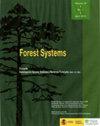湿润热带沿海地区具有重新造林潜力的树种
IF 0.7
4区 农林科学
Q3 FORESTRY
引用次数: 1
摘要
研究目的:温暖潮湿气候下的本土物种五子叶、蔷薇、灰叶、环叶肠虫和alicastrum经常被纳入墨西哥的再造林计划。我们评估了这些物种在沙质土壤中的生长响应,可以作为沿海地区恢复的先驱。研究领域:墨西哥塔巴斯科省弗朗特拉的冲积平原。材料与方法:2014年共种植1080株植物,采用6个重复的随机区组设计,在30个地块进行23个月的评价。每个样地占地36平方米(每个样地种植16株植物)。对存活率、茎高(SH)、基径(BD)和基面积(BA)进行量化。生存变量和生长变量分别采用logistic回归和方差分析进行重复测量。主要结果:实验结束时(2016年),黄芪(G. sepium)和五角草(C. pentandra)的存活率分别为88%和86%,黄芪(B. alicastrum)在6个月时总死亡率较高。SH和BD值以五角草(分别为2.9 m和7.8 cm)和龙葵(分别为2.6 m和4.2 cm)最高。水仙花与五角草的BA值差异显著(分别为5.9和23 m2 ha-1)。研究重点:沙质土壤中,本地种五角草(C. pentandra)和草皮草(G. sepium)具有较高的生存和生长能力;黄皮草对环境具有较强的适应性,五角草具有适宜的盖度,这些特征是造林和恢复成功的必要条件。本文章由计算机程序翻译,如有差异,请以英文原文为准。
Tree species with potential for reforestation in coastal zones of the humid tropics
Aim of study: The native species of warm humid climates Ceiba pentandra, Tabebuia rosea, Gliricidia sepium, Enterolobium cyclocarpum and Brosimum alicastrum are often included in Mexican reforestation programs. We evaluated the growth response in sandy soils of these species that could serve as pioneers in the restoration of coastal areas. Area of study: Alluvial plain in Frontera, Tabasco, Mexico. Material and methods: A total of 1080 plants were planted in 2014 and evaluated for 23 months in 30 plots under a randomized block design with six replications. The sample plots each occupied 36 m2 (each with 16 plants). Survival percentage, stem height (SH), basal diameter (BD) and basal area (BA) were quantified. Survival and growth variables were analyzed using logistic regression and ANOVA for repeated measures, respectively. Main results: At the end of the experiment (2016), high survival was demonstrated in G. sepium (88 %) and in C. pentandra (86 %), while B. alicastrum presented total mortality at six months. The highest values of SH and BD were presented in C. pentandra (2.9 m and 7.8 cm, respectively) and in G. sepium (2.6 m and 4.2 cm, respectively). Gliricidia sepium differed significantly from C. pentandra in terms of BA (5.9 vs. 23 m2 ha-1, respectively). Research highlights: The native species C. pentandra and G. sepium presented high survival and growth in the sandy soils; G. sepium showed strong adaptation to the environment and C. pentandra offered suitable coverage, characteristics that are necessary for the success of reforestation and restoration programs.
求助全文
通过发布文献求助,成功后即可免费获取论文全文。
去求助
来源期刊

Forest Systems
FORESTRY-
CiteScore
1.40
自引率
14.30%
发文量
30
审稿时长
6-12 weeks
期刊介绍:
Forest Systems is an international peer-reviewed journal. The main aim of Forest Systems is to integrate multidisciplinary research with forest management in complex systems with different social and ecological background
 求助内容:
求助内容: 应助结果提醒方式:
应助结果提醒方式:


